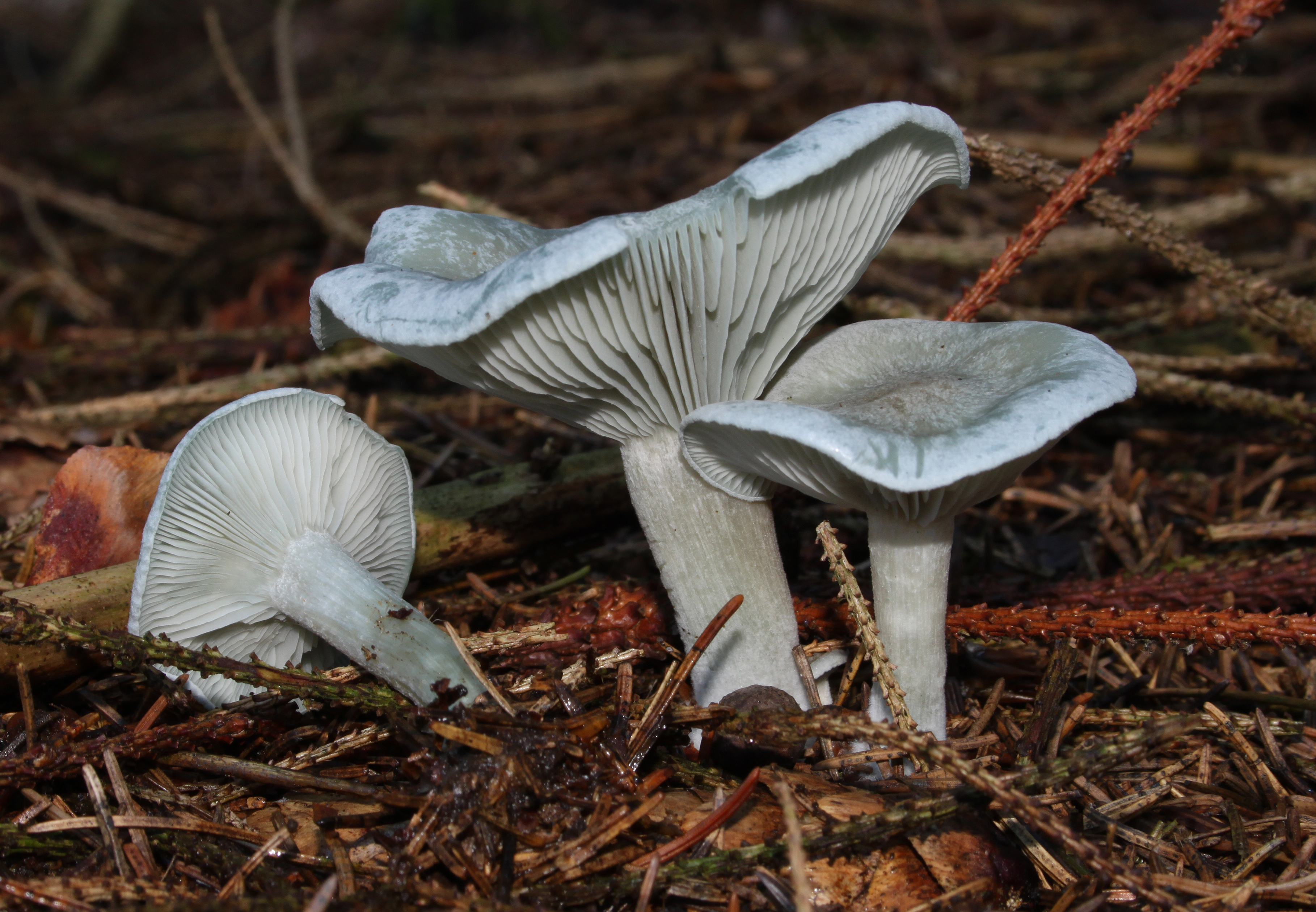Clitocybe Imaiana on:
[Wikipedia]
[Google]
[Amazon]
''Clitocybe'' is a genus of mushrooms characterized by white, off-white, buff, cream, pink, or light-yellow spores, Lamella (mycology), gills running down the stipe (mycology), stem, and pale white to brown or lilac coloration. They are primarily saprotrophic, decomposing forest ground litter. There are estimated to be around 300 species in the widespread genus.
''Clitocybe'' means ''sloping head''.
A few members of the genus are considered edible mushroom, edible; many others are poisonous mushroom, poisonous, containing the toxin muscarine among others. Distinguishing individual species of ''Clitocybe'' is generally prohibitively difficult to non-experts, requiring the analysis of microscopic characters. Therefore, with the exception of a few charismatic and readily identified members, ''Clitocybe'' mushrooms are rarely collected for consumption.
 Many small ''Clitocybe'' species contain the toxin muscarine, which was originally found in small amounts in the famous fly agaric. However, the small white ''Clitocybe'' species contain muscarine in dangerous amounts, and two species in particular, the closely related ''Clitocybe dealbata'' and ''Clitocybe rivulosa'', contain muscarine in such amounts that deaths have been recorded for eating those two ''Clitocybe'' species.
Many small ''Clitocybe'' species contain the toxin muscarine, which was originally found in small amounts in the famous fly agaric. However, the small white ''Clitocybe'' species contain muscarine in dangerous amounts, and two species in particular, the closely related ''Clitocybe dealbata'' and ''Clitocybe rivulosa'', contain muscarine in such amounts that deaths have been recorded for eating those two ''Clitocybe'' species.
''Clitocybe'' at Mushroom Expert.com
{{Authority control Clitocybe, Agaricales genera
Taxonomy
''Clitocybe'' was originally proposed by Elias Fries in 1821 as a tribe (biology), tribe in the genus ''Agaricus''. Friedrich Staude elevated it to generic status in 1857. Recent molecular phylogenetics, molecular work has shown the genus to be polyphyletic: many members are seemingly distantly related and other fungi, such as the field blewit and wood blewit, now known as ''Clitocybe saeva'' and ''C. nuda'' respectively, are more closely related. As ''Clitocybe nebularis, C. nebularis'' is the type species, those most distantly related to it would be likely to be reclassified in the future. In a 2003 paper, Finnish mycologist Harri Harmaja proposed ''Clitocybe geotropa, C. geotropa'' and twelve other ''Clitocybe'' species be split off into a new genus ''Infundibulicybe'' on the basis of spore properties. His ''Ampulloclitocybe clavipes, C. clavipes'' was later transferred to the genus ''Ampulloclitocybe'' by Redhead and colleagues, that genus name taking precedence over Harmaja's proposed ''Clavicybe''. Other former ''Clitocybe'' species have been placed in the genera ''Atractosporocybe'', ''Leucocybe'' and ''Rhizocybe''.Toxicity
The consumption of two species, ''Clitocybe acromelalga'' from Japan, and ''Clitocybe amoenolens'' from France, has led to several cases of mushroom-induced erythromelalgia which lasted from 8 days to 5 months. Many small ''Clitocybe'' species contain the toxin muscarine, which was originally found in small amounts in the famous fly agaric. However, the small white ''Clitocybe'' species contain muscarine in dangerous amounts, and two species in particular, the closely related ''Clitocybe dealbata'' and ''Clitocybe rivulosa'', contain muscarine in such amounts that deaths have been recorded for eating those two ''Clitocybe'' species.
Many small ''Clitocybe'' species contain the toxin muscarine, which was originally found in small amounts in the famous fly agaric. However, the small white ''Clitocybe'' species contain muscarine in dangerous amounts, and two species in particular, the closely related ''Clitocybe dealbata'' and ''Clitocybe rivulosa'', contain muscarine in such amounts that deaths have been recorded for eating those two ''Clitocybe'' species.
Selected species
*''Clitocybe agrestis'' *''Clitocybe albirhiza'' *''Clitocybe amarescens'' *''Clitocybe brumalis'' – winter funnel cap *''Clitocybe cerussata'' *''Clitocybe cistophila'' – Europe *''Clitocybe costata'' – may be edible but due to its rareness it is not consumed. *''Clitocybe dealbata'' – ivory funnel, sweating mushroom – Europe, poisonous *''Clitocybe dilatata'' – poisonous *''Clitocybe ditopus'' *''Clitocybe eccentrica'' *''Clitocybe entoloma'' *''Clitocybe eucalyptorum'' *''Clitocybe fennica'' *''Clitocybe fragrans'' – fragrant funnel *''Clitocybe gilvaoides'' *''Clitocybe glacialis'' *''Clitocybe globispora'' *''Clitocybe glutiniceps'' *''Clitocybe lohjaensis'' *''Clitocybe marginella'' *''Clitocybe menthiodora'' *''Clitocybe nebularis'' – clouded agaric – considered edible by some, though causes gastric upset in many people *''Clitocybe odora'' – aniseed toadstool – grows near birch trees, but can be easily mistaken for poisonous ones mainly because of its appearance *''Clitocybe paraditopa'' – Australia *''Clitocybe parasitica'' *''Clitocybe rivulosa'' – fool's funnel – Europe, North America *''Clitocybe ruderalis'' *''Clitocybe sclerotoidea'' *''Clitocybe strigosa'' *''Clitocybe subcordispora'' *''Clitocybe tarda'' *''Clitocybe truncicola'' *''Clitocybe vibecina'' * ''Clitocybe violaceifolia''Taxonomic status unclear
*''Clitocybe maxima'' – giant clitocybe – taxonomic status unclear, with ''Pleurotus giganteus'' and ''Infundibulicybe hongyinpan'' mistaken for this speciesReclassified
*''Clitocybe acromelalga'' – now ''Paralepistopsis acromelalga'' *''Clitocybe alexandri'' – now ''Clitopaxillus alexandri'' *''Clitocybe amoenolens'' – paralysis funnel – now ''Paralepistopsis amoenolens'' *''Clitocybe brunneocephala'' – now ''Collybia brunneocephala'' – edible *''Clitocybe nuda'' – ''Lepista nuda'' – ''Collybia nuda'' – wood blewit – a common edible distinguished in part by its lilac hue *''Clitocybe candicans'' – now ''Leucocybe candicans'' *''Clitocybe catinus'' / ''Infundibulicibe catinus'' – a white form of ''Infundibulicybe gibba'' *''Clitocybe clavipes'' – may be edible but poisonous when consumed in conjunction with alcohol – now ''Ampulloclitocybe clavipes'' *''Clitocybe connata'' – inedible, suspected to be mutagenic – now ''Leucocybe connata'' *''Clitocybe geotropa'' – trooping funnel, monk's head agaric – now ''Infundibulicybe geotropa'' *''Clitocybe gibba'' – now ''Infundibulicybe gibba'' The bioluminescent jack o'lantern mushroom (''Omphalotus olearius'') was formerly placed in this genus as ''Clitocybe illudens''.See also
*List of Tricholomataceae genera * Mushroom hunting * Mushroom poisoningReferences
External links
''Clitocybe'' at Mushroom Expert.com
{{Authority control Clitocybe, Agaricales genera